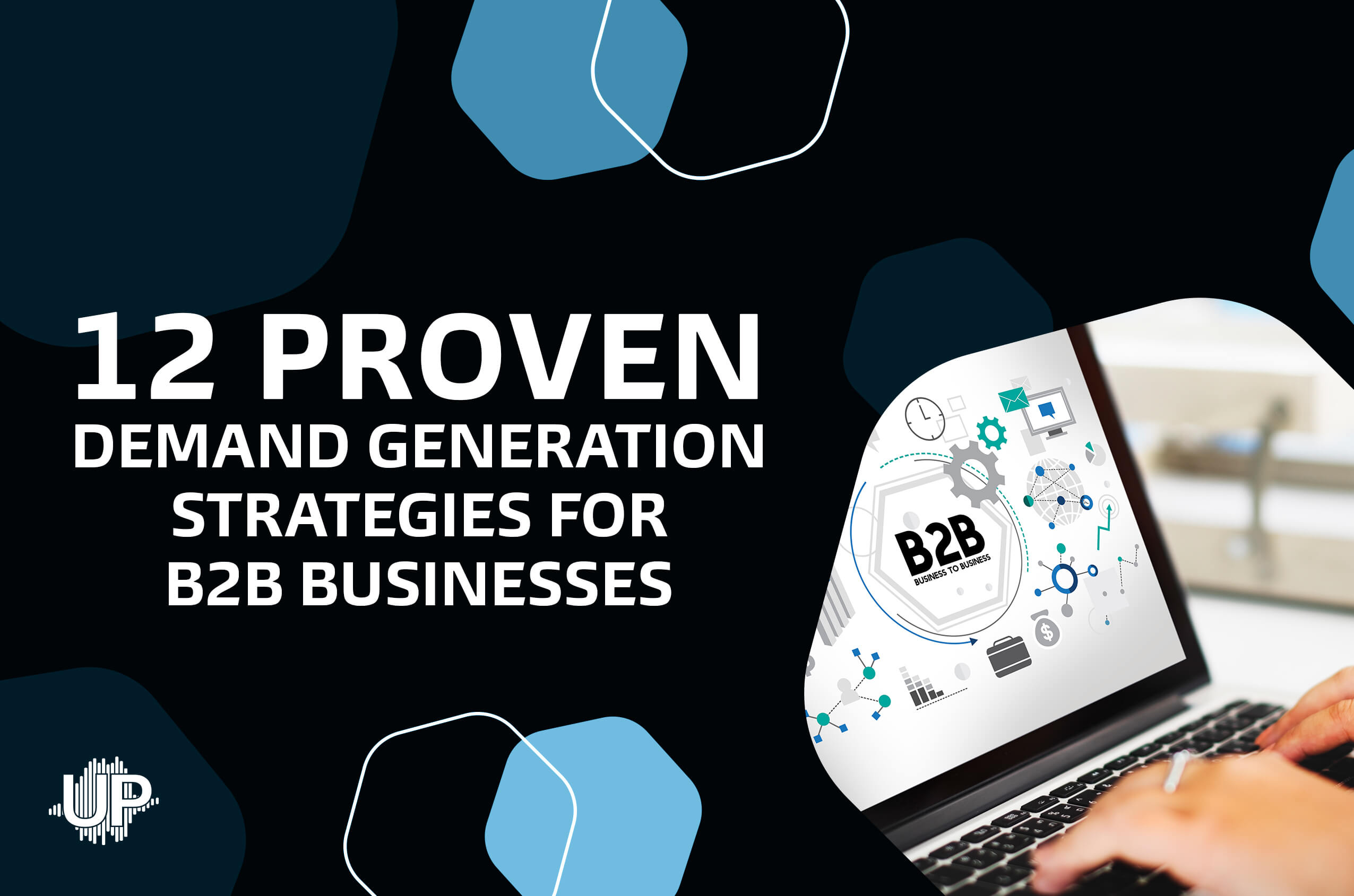
What Is B2B Demand Generation?
B2B demand generation strategies are all about creating interest and demand for a company's products or services within other businesses.
You generate high-quality leads that are likely to convert into customers.
It's also a strategic process focused on making meaningful connections with the right potential clients. It's not just about marketing.
It's a blend of marketing, sales, and customer relationship efforts, all finely tuned to guide prospects towards a resounding “yes” to what you're offering.
How Does B2B Demand Generation Strategies Work?
In B2B transactions, buying decisions aren't made on a whim. It's a comprehensive journey involving multiple decision-makers. This reality demands a strategy that's sharp and focused.
You can't rely on broad, scattergun advertising tactics. Instead, it's all about precision targeting—delivering your message to the right people at exactly the right time.
Let's say you're marketing a niche software solution. Your target isn't every business out there. You're aiming for those who genuinely need your unique technology. The key to attracting these prospects? Offer content that's more than just informative—it must be enlightening.
This includes well-crafted articles, engaging webinars, and insightful resources that showcase your software as a solution specifically designed to address their unique challenges.
By doing so, you're positioning it as a vital tool that can transform the way they tackle their specific problems.
How Do You Measure B2B Demand Generation for Businesses?
Measuring demand generation in B2B businesses is crucial for understanding the effectiveness of your strategies and making data-driven decisions for future campaigns. Here are the key metrics and approaches:
- Lead Generation: Count those potential customers, but focus on quality. Are they likely to convert into buyers?
- Conversion Rates: This one's critical. It shows if your leads are turning into paying customers. High conversion? You're on target.
- Engagement: Check if people interact with your content, like reading articles or joining webinars. More engagement equals more interest.
- Sales Cycle Length: How quickly are leads turning into customers? A shorter cycle often means your strategies are working well.
- Customer Value: Look at how much your customers are spending over time. Higher spending means you're attracting the right kind of clients.
Keep an eye on these metrics, and you'll have a solid handle on the effectiveness of your demand generation efforts.
B2B Demand Generation Strategies #1: Improve Your Demand Funnel Framework
This is crucial for any business looking to attract, effectively convert and retain customers. In today's market, it's about guiding them smoothly and efficiently through their journey, from the moment they discover your brand to the point they purchase.
Understanding and meticulously organizing each stage is the key to a booming demand funnel. It's like constructing a well-oiled machine where every gear and part plays a specific, vital role.
- Define Funnel Stages: Establish clear and purposeful stages in your demand funnel.
- Identify Metrics: Choose relevant metrics to gauge funnel performance.
- Align Content and Messaging: Customize content to engage potential customers at each funnel stage.
- Enhance Lead Scoring and Nurturing: Implement strategies to prioritize and maintain engagement with leads.
- Analyze and Optimize Continuously: Regularly review and improve the funnel based on performance data.
B2B Demand Generation Strategies #2: Podcasting
Podcasting is a platform for thought leadership. By sharing valuable insights, industry trends, and expert interviews, you position your brand as a knowledgeable and reliable source in your field. This is where the magic happens – building trust with your audience.
Podcasting in the B2B space is a game-changer. By sharing valuable insights, industry trends, and expert interviews, you establish your brand as a leading voice in your industry.
- Create Valuable Content: Offer insightful, industry-specific content.
- Establish Thought Leadership: Showcase your expertise to build credibility.
- Guest Interviews: Invite industry experts to extend your reach and enrich content.
- Promote on Multiple Channels: Distribute and promote your podcast widely. Read more.
- Call to Action: Include clear calls to action in your episodes.
- Track Performance: Use analytics to refine your content strategy.
- Networking and Partnerships: Build relationships for co-marketing opportunities.
Commit to delivering regular, impactful content through your podcast. It's about igniting meaningful conversations, not just pushing a product. Read more.
B2B Demand Generation Strategies #3: CRM and Marketing Automation Integration
This approach is crucial for businesses looking to amplify their B2B demand generation efforts. By syncing CRM and marketing automation, companies gain a powerful tool for understanding and engaging your B2B audience.
You transform your data into actionable insights, leading to more personalized, effective marketing campaigns and a streamlined sales process.
- Centralized Data Management: Keep all customer data centralized for a complete customer view.
- Personalized Marketing Campaigns: Use CRM data for tailored marketing efforts.
- Streamlined Sales and Marketing Alignment: Align sales and marketing with unified data.
- Efficient Lead Management: Automate lead capture and follow-up processes.
- Enhanced Analytics and Reporting: Utilize combined data for comprehensive analytics.
- Automated Customer Journey Management: Manage the customer journey from initial contact to conversion.
- Improved Customer Insights: Gain deeper insights for informed marketing and sales strategies.
Merging CRM and marketing automation means more innovative, tailored, and efficient B2B demand generation. It's all about optimizing relationships and converting leads into loyal customers.
B2B Demand Generation Strategies #4: Optimize Your Lead Nurturing in B2B
Effective lead nurturing in B2B is about fostering trust and positioning your business as the ideal solution for their needs. This means segmenting your leads effectively and tailoring your communication to meet their specific needs.
Each interaction should add value, build trust, and guide your prospects closer to a decision. Remember, effective lead nurturing is proactive, not reactive.
- Your Leads: Each lead is unique. Get to the core of their specific needs and buying stage. Tailor your interactions to these distinct factors.
- Educational Content: Share content that hits the mark—think blog posts, whitepapers, webinars—aligned with your leads' challenges.
- Consistent Communication: Keep up regular contact via emails, social media, or direct outreach. It's about staying on their radar, but be strategic to avoid overwhelming them.
- Feedback Loop: Watch how leads react to your content. Which types resonate more? Use this feedback to refine your approach.
Every interaction should guide the potential customer closer to a decision that aligns with your offer.
B2B Demand Generation Strategies #5: Lead Scoring in B2B Marketing
Implementing a robust lead scoring system allows your sales team to focus their efforts on the most promising leads. You're using data-driven insights to assess where a lead stands in their buying journey and how likely they are to convert.
This means analyzing their engagement levels and behaviors that fits with your ideal customer profile. It ensures that your team invests time in leads with the highest conversion potential.
- Set Clear Scoring Rules: Nail down what makes a lead score high or low. Consider factors like industry relevance, company size, position, and how they interact with your content.
- Point System: Allocate points based on your criteria. A lead from your target industry? Higher points. Someone regularly engaging with your content? Also high up on the score chart.
- Embrace Automation: Tap into marketing automation tools for scoring. It's about saving time and keeping your scoring consistent.
- Stay Current: Your lead scoring should evolve with your business. Keep an eye on market shifts and tweak your criteria to keep it spot-on.
By refining your lead scoring, you're snappily focusing your energy on those most likely to seal the deal. It makes your B2B demand generation more targeted and efficient.
B2B Demand Generation Strategies #6: Account-Based Marketing (ABM)
ABM flips the traditional marketing funnel on its head. Instead of casting a wide net, ABM focuses on key accounts that align perfectly with your business offerings.
It's about identifying high-value prospects and crafting personalized marketing campaigns addressing their needs and pain points. The goal is to create a unique, engaging experience for each selected account, fostering deeper connections and driving real results.
- Pick Your Players: Start by picking companies that perfectly match your offerings. Look for those who'll benefit the most from what you have.
- Tailored Tactics: For each chosen account, create a marketing playbook that's as unique as they are. Think customized content, messaging, and ads that hit right where it matters.
- Teamwork Makes the Dream Work: Sync your sales and marketing squads. They must be tight-knit, focusing on the same targets, strategies, and goals.
- Measure the Magic: Keep tabs on how your ABM is performing. Track engagement, conversions, and their overall effect on sales, and use this data to fine-tune your approach.
This approach requires close collaboration between sales and marketing teams to identify and target these key accounts precisely. It's a concerted effort that involves detailed research, customized content, and targeted communications.
B2B Demand Generation Strategies #7: Webinars and Thought Leadership
Combining webinars and thought leadership is a power move in B2B marketing. This duo will establish your brand as a leader and authority in your field.
Together, they're a dynamic force for generating demand and forging strong, lasting connections with your audience. In a world where everyone's bombarded with information, standing out as a reliable, knowledgeable source is key.
- Expertise on Display: Use webinars to showcase your deep insights and fresh ideas, underlining your company's thought leadership.
- Real-Time Engagement: Webinars should be interactive, offering a platform for direct engagement, answering questions, and diving into industry trends.
- Smart Topic Choices: Pick webinar topics that showcase new, innovative thinking in your field.
- Content Consistency: Regularly publish content that aligns with your webinar themes.
- Industry Event Presence: Speaking at events can amplify your webinar messages.
Social Media Savvy: Stay active on platforms like LinkedIn, sharing insights and joining conversations.
Using webinars and thought leadership together can turbocharge your B2B demand generation. You deliver value, engage deeply, and position your brand as the industry's go-to expert.
B2B Demand Generation Strategies #8: B2B Content Marketing Strategy
A solid Content Marketing Strategy is key for driving demand. It's about crafting and sharing top-notch content that grabs attention and connects with your target audience, meeting their needs and showcasing your brand as the go-to solution.
Let's break down how strategic content marketing is a game-changer in B2B demand generation:
- Hitting the Target Audience: It's about drawing in the right crowd. Tailor your content to address your target market's specific needs and challenges. This way, you're more likely to attract potential customers who are interested in your offer.
- Building Brand Trust: When you consistently dish out quality, insightful content, you position your brand as a leader and trusted source in your industry. This trust factor is huge in B2B.
- Nurturing and Engaging Leads: Keep your audience engaged with relevant content. This nurtures potential leads, guiding them closer to a purchase decision.
- Boosting Your Online Game: SEO-friendly content ups your online presence, making it easier for potential customers to find you.
Encouraging Interaction: Content that's informative and interactive boosts engagement. It gets potential clients talking and interacting with your brand, expanding awareness and reach.
B2B Demand Generation Strategies #9: Email Marketing
With businesses craving real, personalized connections, email marketing shines. It's about using targeted, personalized emails to engage, educate, and convince potential clients. Let's dive into what makes email marketing a winner in B2B:
- Direct, Customized Connection: Email lets you hit straight to your target audience with content that's tailored to their needs and interests. This personal approach is vital in B2B, where buying decisions need a deep grasp of the client's business.
- Lead Nurturing: Regular, informative emails keep your brand in mind for potential customers. They guide them step-by-step through the sales process.
- Budget-Friendly Outreach: Email marketing reaches a broad audience without breaking the bank, delivering great ROI.
- Trackable Success: You can monitor key metrics like open and click-through rates and conversions with email. This lets you gauge campaign success and steer your strategy with hard data.
- Building Lasting Bonds: Consistent value through emails helps cement long-term relationships with clients. In B2B, it's less about one-off sales and more about forging lasting partnerships.
Email marketing in B2B demand generation is a strategic tool for creating meaningful connections, nurturing leads, doing it cost-effectively, measuring impact, and building enduring client relationships.
B2B Demand Generation Strategies #10: B2B Social Media Marketing
Social media offers a space to share content and build relationships, gain insights, and engage directly with your audience. Let's break down its role in boosting demand generation:
- Amplifying Brand Visibility: Stay active on key social platforms to boost your brand's visibility. It's the starting block for drawing in potential clients.
- Direct Audience Engagement: Use social media for real conversations with your audience. Through interactive posts, comments, and discussions, you get to know your potential clients, tailor your offerings, and show your brand's relevance.
- Content Sharing Powerhouse: It's a prime channel for spreading your blogs, case studies, and whitepapers. This flaunts your expertise, drives traffic to your site, and generates leads.
- Cementing Thought Leadership: Post content that showcases your industry smarts. This builds your reputation as a thought leader, which is vital for trust and credibility in B2B.
- Showcasing Social Proof: Share client testimonials and success stories. This kind of social proof boosts your brand's reputation and nudges potential clients your way.
- Networking and Alliances: Social platforms are great for making connections, forming partnerships, and opening doors to new business opportunities and referrals.
B2B social media marketing is about much more than just showing up. It's about active engagement, sharing expertise, building trust, and tapping into new opportunities.
B2B Demand Generation Strategies #11: Referral Programs and Partnerships
Referral programs and partnerships are invaluable for B2B companies. They harness trust and existing connections, effectively boosting demand generation and broadening your market footprint.
- Trust-Based Growth: When your current clients refer to new ones, you leverage established trust. A recommendation from a trusted source holds weight and drives consideration.
- Cost Efficiency: Gaining customers through referrals or partnerships is often more budget-friendly than traditional marketing tactics. It's an innovative, economical growth strategy.
- Credibility Boost: Teaming with respected companies can elevate your brand's reputation. These associations enhance how your brand is perceived in the business world.
- Market Reach: Strategic partnerships can be your ticket to new markets and customer groups that might otherwise be tough to crack.
Bottom Line
Ultimately, the goal of B2B demand generation is to establish and nurture long-term customer relationships. It's about building a brand reputation that resonates with your target audience, encouraging loyalty, and fostering ongoing engagement. Read more.
By building relationships and providing value, businesses can ensure a steady stream of demand, paving the way for growth and success in the competitive B2B space.
Read more about 5 New Ways to Get B2B Leads in 2024
Listen to the Thoughtful Entrepreneur
More Resources from UpMyInfluence:
How to Be An Exceptional Podcast Host

